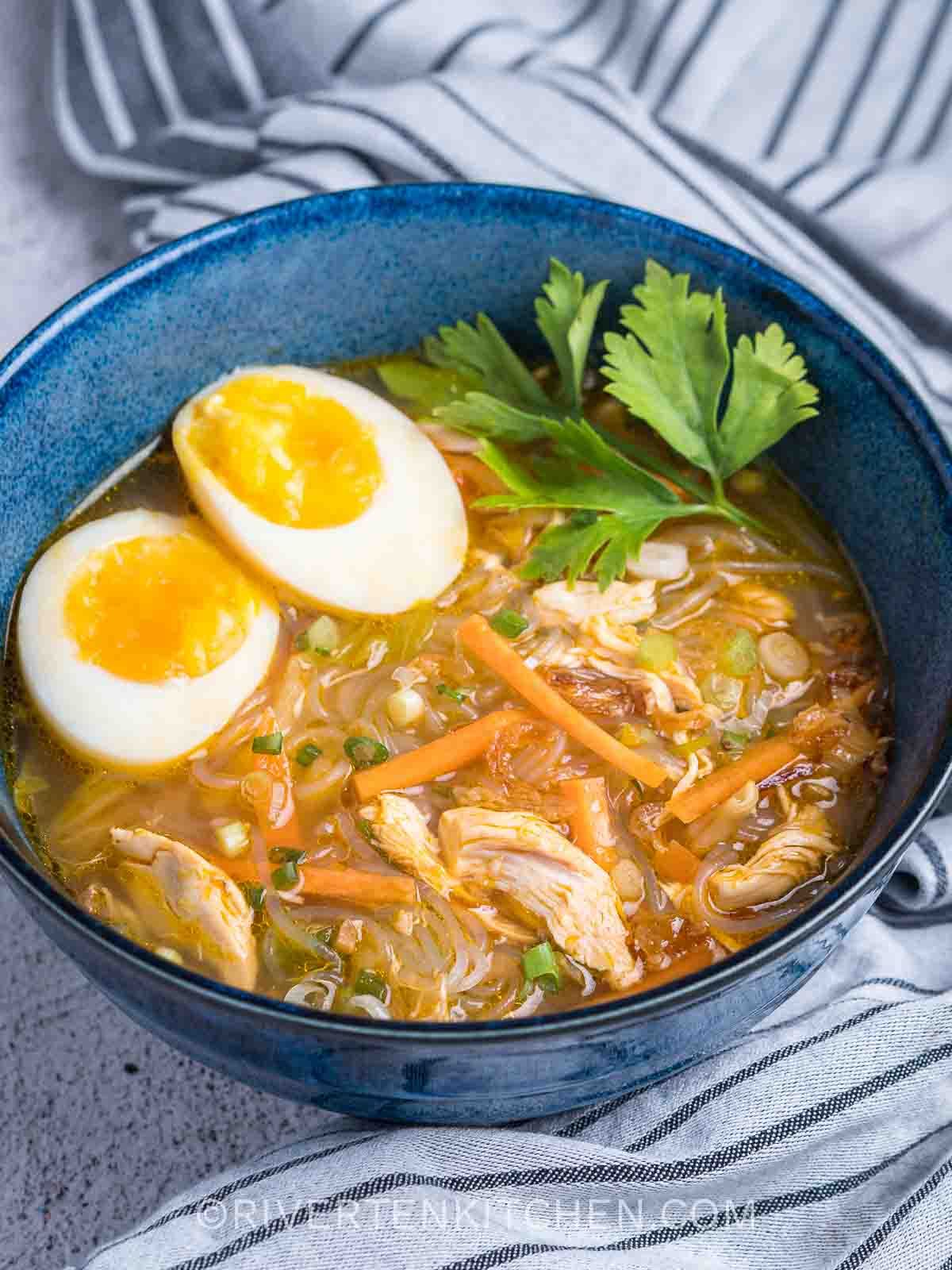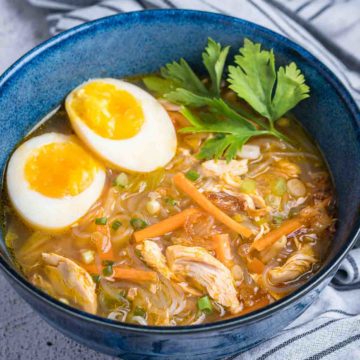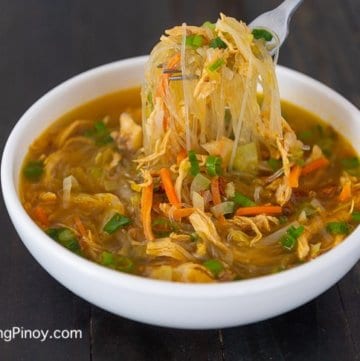Best part of chicken for sotanghon soup?
Use bone-in, skin-on chicken to make a flavorful soup. I use various chicken parts in this recipe, including the thighs, breasts, wings, and legs.
Although you can pretty much add any mildly flavored vegetables to this soup, the essential components of chicken sotanghon are carrots and napa cabbage (my personal favorite).
Here are other vegetables you can add:
Use the best chicken bouillon or broth you can find. And for that distinctive Filipino flavor, don’t forget the fish sauce. I swear it’s a huge improvement over using just salt.
I also love adding Chinese celery, also known as leaf celery instead of “regular” celery for its aromatic leaves. You can find this in most Asian supermarkets.
Just like kare kare, chicken sotanghon is also known for its “orange-ish” color. This is due to the use of annatto seeds. Its a natural food coloring from the plant called achiote tree. This is completely optional. So dont worry if its not available.

The following are my top recommendations for the best chicken sotanghon soup you’ve ever had:
Chicken sotanghon is filling on its own. However, you can add some eggs—either hard-boiled or soft-boiled—for more protein.
Garnish with green onions and toasted garlic just before serving.
Similar to any other soup, this is best served hot from the oven.
Glass noodles soak up liquid very well. Prior to adding it to the soup, it must be pre-soaked to prevent it from absorbing too much liquid. In case you need to add more liquid to the soup, have hot water on hand.
Remove the skin and trim the excess fat from the meat if you’re watching how much fat you consume. You can also double the vegetables if preferred.
Try these next

How to Cook Chicken Sotanghon Soup
This Pinoy chicken noodle soup version is easy to make. Cooking can be completed in less than 20 minutes if the ingredients are prepared beforehand.
The chicken needs to be prepped in this recipe. This is the reason why it took a bit longer.
Start by making annatto water. Combine annatto seeds with warm water and then stir. Soak for 10 minutes. Use a kitchen sieve to filter the seeds, then reserve the colored water.
We need shredded chicken for this recipe. Chicken needs to be cooked thoroughly and then shredded afterwards. Start by boiling water in a cooking pot. Add a piece of dried bay leaf for extra aroma. Put chicken in the pot and boil for 20 minutes. Chicken should be removed and allowed to cool before being manually shredded. If you don’t want the skin in your soup, I advise removing it. Save the chicken stock. It is needed for the soup.
The actual cooking process is straightforward after preparing the ingredients. This entails sautéing the aromatics, including the celery, onion, and garlic. To give your soup that lovely roasted garlic flavor, be sure to brown the garlic. Before pouring the stock, add the chicken and saute for a few minutes.
Chicken Sotanghon Soup should be tasty. A piece of Knorr Chicken Cube added gives the dish that dependable chicken flavor. I like my soup to be somewhat orangey in color. Annato water does this for me.
Add the sotanghon noodles and cook for approximately 10 minutes. Even just using carrots and cabbage as the only vegetables in this soup is sufficient. However, feel free to add other veggies if desired. Before seasoning with patis and freshly ground black pepper, add the vegetables to the pot and cook for a few minutes.
I also add roasted garlic and chopped scallions. These makes a huge difference.
Try this Chicken Noodle Soup Recipe. Let me know what you think.

Chicken Sotanghon SoupA Filipino version of chicken noodle soup. This dish is composed of shredded chicken breast and vermicelli with carrots and cabbage.
FAQ
What is sotanghon noodles made of?
Sotanghon goes by many names. It’s more popularly known as vermicelli or cellophane noodles. Once cooked, these noodles turn transparent or translucent, earning them the name “glass noodles.” It’s commonly made out of mung bean (monggo) starch.
Is sotanghon same as glass noodles?
The Filipino word for glass noodles made of mung bean starch is sotanghon. While rice noodles are opaque, glass noodles are semi-translucent. Thus, also sometimes called cellophane noodles. When cooked, glass noodles become chewy and springy in texture.
Is sotanghon and bihon the same?
Sotanghon is more gelatinous and appears translucent after cooking, while bihon will turn white and become more opaque. As a result, sotanghon typically feels slicker. Additionally, bihon is frequently made as a thinner noodle than sotanghon.
What is sotanghon in English?